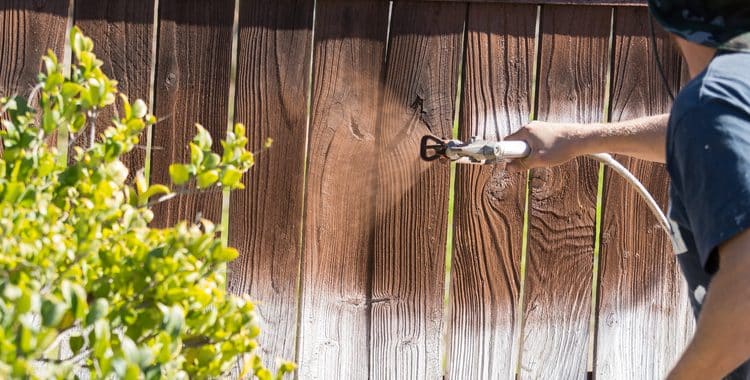I remember using creosote to treat a fence when I was a teenager. The stink of the stuff and the way I couldn’t wash it off my hands was a real cause for concern – especially as there’s some evidence it’s toxic (see our disclaimer below). However, many people still use it so we thought we’d answer this specific question about using creosote on damp wood…
You cannot creosote damp wood, as this would lock in moisture causing the wood to go moldy and rot from the inside. Wood needs to be dried for at least two weeks before applying creosote, and the creosote needs 24 to 48 hours of sunshine to fully dry.
Let’s look at some directions of use for creosote and consider how long it takes to dry and whether you can paint over wood that’s been treated with it. We’ll also discover if it’s really safe to use creosote at all.

Is it OK To Creosote Wet Wood?
Nope. Not really. It’s best to creosote dry wood. If you creosote already damp wood, it simply locks in the moisture.
But first, what even is creosote? Why and how do you use it?
Creosote, or coal tar creosote or creosote oil, is a wood preservative. It has been used since the 1700s, when it was known as “oyle of tarr”. Traditionally, creosote was used by boatbuilders and on outdoor structures to prevent rot. For a while, it was used as a cattle wash or sheep dip. Later, when the railroad industry was growing, creosote was used on railroad ties.
In the year 2019, an estimated 22 million creosote-treated railroad ties were installed in railways across the US. They estimate they will last up to 35 years, as compared to untreated wood, at 5 years. The useful life of a creosote-treated utility pole exceeds 75 years.
Creosote has a natural toxicity to fungi, insects, and marine borers. It is naturally water repellent. Creosote is used on piling, railroad ties, telephone poles, and fence posts. Creosote is suitable for rough, sawn, or smooth timber, used outdoors. It protects against water damage and prevents timber from drying out or splitting.
Since 2003, only professional operators can buy traditional creosote. It is considered a restricted-use pesticide. The agricultural community and builders are still allowed to buy creosote, providing they don’t resell to general householders.
So: is it OK to creosote damp wood? Nope. Creosote is a sealant. You don’t want to seal in dampness. Not only that – it may not stick. Creosote is an oil-based product.
How Long Does Wet Wood Need To Dry Before Creosoting?
Experts say up to 2 weeks. Of course, the time will depend on the amount of sunshine and the air temperature. It also depends on your area’s average humidity. And whether it’s windy. For firewood, the rule of thumb for “seasoned” wood is from 6 to 9 months – they prefer a year.
The problem here is that the moisture in your timber won’t be able to escape naturally once you seal it with creosote. Not only that, but creosote is an oily treatment. Oil and water don’t mix, as we all know. Creosote might not stick unless the timber is well and truly dry.
Because there’s such a range in drying times, you could consider testing a small area of your timber first to see if the creosote will stick. Paint a small area, wait the 24 to 48 hours that are recommended drying times and see how the creosote sticks.
Can I Use Creosote in The Rain?
The problem is that, if it’s a real downpour, the creosote will simply wash off before it can harden. Creosote needs 24 to 48 hours of sunshine to dry.
Experts recommend that you wait at least 24 hours after a downpour to apply creosote. If you think your wood is dry enough, test out a small area to see if the oil-based creosote will stick. Let it dry the recommended 24 to 48 hours and then try to rub it off.
Is Creosote Waterproof?
Nope. Not waterproof. Only water resistant.
Creosote is somewhat oily. The oiliness protects wood against water damage and water ingress. It prevents swelling and cracking.
How Long Does Creosote Take To Dry?
This depends on the conditions. Is it a sunny day? Cloudy and moist?
In ideal conditions, creosote will take 24 to 48 hours to dry. Here’s a creosote information page.
Can I Paint Over Creosote?
You can paint over creosote but be warned that many manufactured timbers treated with creosote were pressure treated. Creosote was forced into the wood, sometimes all the way through.
Here are some steps. You will need to buy aluminum paint, primer-sealer and then your actual paint (exterior, oil-based). Oil based is best for all of these, so be sure you have some thinner or turps.
- Use a wire brush to remove all the loose wood bits and dirt.
- Apply the aluminum paint first – be sure to totally cover the creosote.
- The sealer-primer is next. A lacquer-based primer is best.
- Apply another coat of primer.
- Finish with a coat of the exterior house paint.
- Apply one more coat of exterior house paint.
Some experts recommend using two coats of urethane, epoxy, or shellac to seal creosote. There are other products, like CreoShield™, to provide environmental shields over old creosote.
There are also creosote-stripping products for wood and masonry.

Can You Burn Wood Treated With Creosote?
Nope. Absolutely not. Burning wood treated with creosote gives off toxic fumes.
In fact, you shouldn’t inhale the fumes that come off creosote-treated wood on a sunny day. You may feel lightheaded or dizzy. Some people feel nausea, shortness of breath and disorientation.
Creosote fumes disrupt the level of oxygen to your brain. The fumes can irritate your nose, skin, and eyes. Fumes can cause nosebleeds.
The best way to dispose of creosote-treated wood is at your transfer station as trash.
Final Thoughts: Are There Any Downsides To Creosote?
Disclaimer: We are not medical professionals here at Take a Yard, but it’s important to point point out here that if you’re thinking of using it, creosote could cause cancer.
As usual, there are a lot of different opinions and scientific studies. One study looked at creosote workers and could find no evidence to support an increase in health issues. One of the environmental study challenges is that creosote-treated wood can last for 40 to 60 years – some over 100 years!
In 2003, the European Commission banned the sale of creosote-treated wood due to the health risks. Since then, you have to be a professional to purchase creosote. In some stores, you will have to log in as a contractor.
The Environmental Protection Agency (EPA) recommends that you not use creosote-treated wood in gardens or other residential applications. According to the Agency for Toxic Substances and Disease Registry, creosote can enter your body through your nose, your mouth or by skin contact.
The problem with creosote-treated wood is the toxicity of the creosote. It can give off fumes if above ground. If below ground, the toxic chemicals can leach into the soil and then into the water table. Creosote is a known toxin to fish and other aquatic life.
Creosote fumes can cause respiratory illnesses. Creosote is made with a surprisingly large number of chemicals – up to a thousand. One of them, naphthalene, is a known carcinogen. Folks living in homes made with creosote-treated wood report that the fumes cause headaches and stomach issues.
If creosote-treated wood has been used for picnic tables, landscaping, or other places where there might be contact with skin, it can cause rashes and blistering. Creosote can also effect your vision.
If you are going to come into contact with creosote, wear skin protection and synthetic rubber gloves. Do not breathe in the spray mist. When using creosote, don’t eat, drink or smoke. Keep animals away from the fumes. If spraying creosote, avoid all contact with plant life and cover water storage tanks.
Take extra precautions if you need to cut creosote-treated wood. Wear a mask to avoid breathing in fumes or toxic sawdust. Wear protective clothing – especially long sleeves.
Creosote oil shouldn’t be used: inside buildings, for toys, for playgrounds, in parks, gardens or outdoor facilities, or for garden furniture.
Here’s a good white paper on creosote, what it is and the dangers. You definitely need to be aware of all this before just slapping it all over your fence panels.



